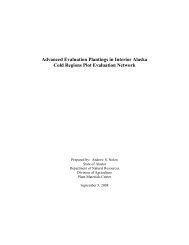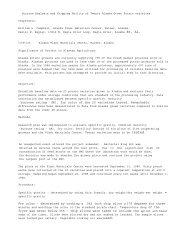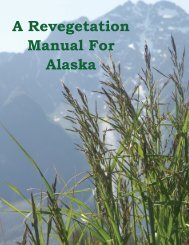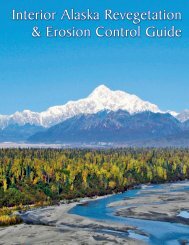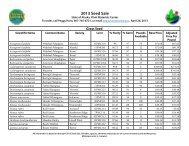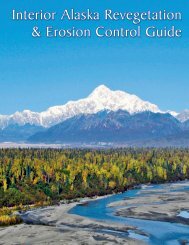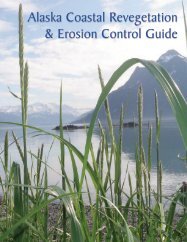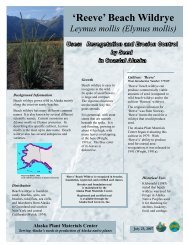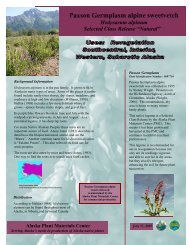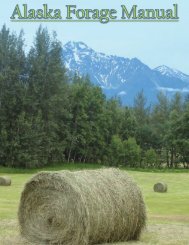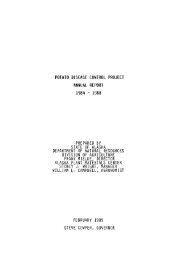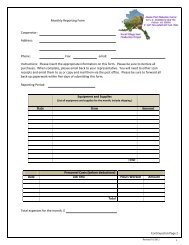Alaska Forage Manual - Alaska Plant Materials Center - State of ...
Alaska Forage Manual - Alaska Plant Materials Center - State of ...
Alaska Forage Manual - Alaska Plant Materials Center - State of ...
Create successful ePaper yourself
Turn your PDF publications into a flip-book with our unique Google optimized e-Paper software.
Purpose<br />
The goal <strong>of</strong> this study was to determine nutrient<br />
content <strong>of</strong> forage species within each distinct<br />
plant growth stage. Five growth stages were examined<br />
for grass, legume, and cereal crop species -<br />
Vegetative, Pre-boot, Boot, Anthesis (flowering) and<br />
Caryopsis (ripening). Samples <strong>of</strong> vegetative matter<br />
were taken at each stage and sent to a lab for nutrient<br />
analysis. Data extrapolated from testing can<br />
be used by producers and consumers as a means <strong>of</strong><br />
choosing forage species based on the needs <strong>of</strong> livestock<br />
and/or wildlife.<br />
An additional intent <strong>of</strong> this study was to look<br />
at the nutritional content <strong>of</strong> native and non-native<br />
plant species, and determine if any non-native species<br />
have sufficiently high nutritional value to warrant<br />
inclusion in forage plantings in <strong>Alaska</strong>. Timothy<br />
and Brome are two examples <strong>of</strong> non-native species<br />
with high nutritional value.<br />
Methods & Procedures<br />
This effort was conducted at <strong>Alaska</strong> <strong>Plant</strong> <strong>Materials</strong><br />
<strong>Center</strong> in Palmer, <strong>Alaska</strong> during the 2011 growing<br />
season. Fields were well established and fairly<br />
free <strong>of</strong> weeds. <strong>Plant</strong> species were evaluated and<br />
growth stages were monitored daily. Each species<br />
collection was accompanied by field observations as<br />
noted by the sample collector. Standardized collection<br />
procedures were followed.<br />
Growth <strong>State</strong> Indicators<br />
1. Vegetative: Leaf growth and development; no<br />
stems<br />
2. Pre-boot: Stem elongation or “jointing”; stem<br />
or culm development occurs<br />
3. Boot: The seedhead (inflorescence) emerges<br />
from the tiller<br />
4. Anthesis (flowering): Pollen starts to shed from<br />
the anthers<br />
5. Ripening: This stage begins with the development<br />
<strong>of</strong> the caryopsis (seed) and ceases when<br />
they are ripe. Also denotes the end <strong>of</strong> the growing<br />
season; leaves start to change color.<br />
Species Collection<br />
1. A handful <strong>of</strong> grass was clipped with scissors, leaving<br />
about 2-3 inches <strong>of</strong> stubble above ground.<br />
Five samples were collected for each species.<br />
2. Each sample was cut into sections <strong>of</strong> approximately<br />
8 inches in length, placed into a five gallon<br />
bucket and then mixed together so representative<br />
samples could be taken. Any decadent<br />
(previous year’s) growth was removed so that<br />
only the current season’s growth was analyzed.<br />
3. Approximately 200 grams <strong>of</strong> grass was removed<br />
from the five gallon bucket and put into a ½ gallon<br />
bag. Each bag was labeled with date, species<br />
name, and growth stage.<br />
4. Samples collected were delivered the same day<br />
to the University <strong>of</strong> <strong>Alaska</strong> Fairbanks Experiment<br />
Farm for testing.<br />
84



